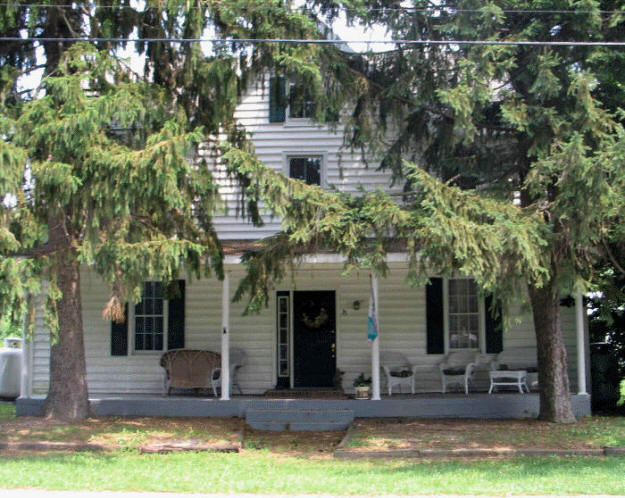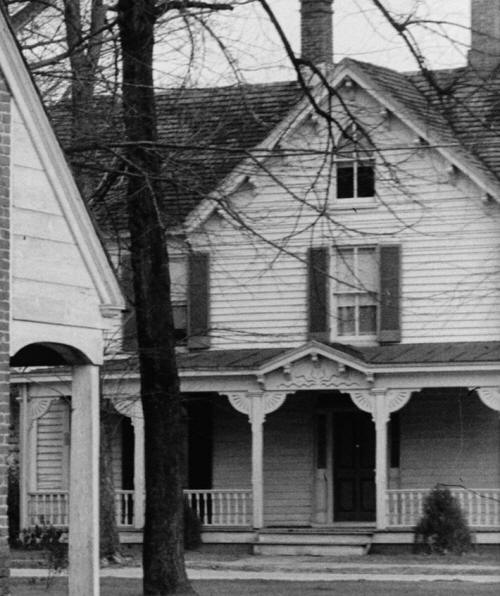East New Market
Property Reports
35 Main Street
The Old Tavern (bef. 1795)
(Also known as The Olde Shanty, The Tavern House, and New Market Hotel)

In 1795 James Sulivane sold the 1 acre lot where John McClaren now lives to Charles Lecompte. John McClaren used the house as a public house and a grocery. An 1829 deed describes the lot as "the old tavern and home dwelling of Mary Ann Travers." Thus both the Old Collins House and the Old Tavern property were likely built by 1829. The Old Tavern was likely the public house where John McClaren lived in 1795. Silas Collins was known to have operated a public house at this location in 1828 and again in 1844 and 1845.
Before 1855, the Old Collins House and the Old Tavern Property were part of the same lot. The "Front Section" was a 1 acre lot that abutted the main street. The "Rear Section" was also 1 acre and was directly behind the "Front Section". Both structures stood on the "Front Section". Sometime after 1809, Mary Ann Travers obtained the "Front Section" as an heir of the elder Charles Lecompte. In 1829, she bought the "Rear Section" and the property became a single 2 acre lot. In 1854, a trustee sold the northernmost 1 acre to William Huffington. This northernmost one acre lot was the site of the Old Collins House. The southernmost 1 acre lot was the Old Tavern property. The property continued as a Tavern and Inn into the 1870s (John Dean 1860, William P. Conaway mid-1860s, and James Lawrence Colston early 1870s.) and maybe later (John F. Ryan 1880).
In 2005, the larger parcel 18, comprises both this property and the property to the north called Johnny's Tavern. James Cheesman (b. 1895) stated in 1990 that Dr. Nichols lived in the house where Warner got.

From New Revised History of Dorchester County, Maryland by Elias Jones, Tidewater Publishers, Cambridge, Maryland - 1966, Chapter X, East New Market, by Miss Emma Edmondson Jacobs 1925
From the older ones much interesting history may be heard of the old days, when the crossroads tavern here would be filled with travelers from the upper and lower peninsula. Frequently did traders from Delaware and New Jersey meet here who came to sell negroes or exchange horses. Iron staples are still shown here in one building to which slave negroes were chained for safe keeping until sold or to await the purchaser's time when ready to convey them South for service in the cotton fields of Georgia.
From "Between The Nanticoke and the Choptank, An Architectural History of Dorchester County, Maryland" Edited by Christopher Weeks, with contributions by Michael O. Bourne, Geoffrey Henry, Catherine Moore, Calvin Mowbray, M. Fred Tidwell.
This house consists of two portions, an older section, probably built in the 1840s, and a later three-bay, two-story section facing the street. The town charter of 1833 refers to a LeCompte tavern in the center of town, from which the town's boundaries were drawn. If this building is the original LeCompte tavern, it would mean that it is substantially older than 1840.
The Laskowski Papers - (The Old Collins Property)
It has been stated that the old Collins house was used in ante bellum days as a tavern. The tavern, however, was the house next to this [this property] and had rings in the floor to which slaves were chained while being taken from one part of the country to the other. The old tavern has been torn down and so renovated that it is now unrecognizable as such.
The Life of John Thompson, A Fugitive Slave, Containing his History of 25 Years in Bondage, and his Providential Escape. Written by himself. 1856 (pages 62-64)
The vessel soon arrived in port, when George was put in irons, and confined in a slave pen among a drove of slaves, in New Market...
When she reached the pen, she was conducted up stairs to a room, in the middle of which was a long staple driven into the floor, with a large ring attached to it, having four long chains fastened to that. To these were attached shorter chains, to which the slaves were made fast by rings around their ankles. Men, women and children were huddled in this room together, awaiting the arrival of more victims, as the drove was not full.
In this miserable condition did Mrs. Nichols, who had served out her time, find her son; who was as much entitled to his freedom as she was to hers. And in this condition she left him forever! Would that the Rev. Dr. Adams and others, who paint slavery in such glowingly beautiful colors, could have seen this, and have heard the agonizing cries of that mother and child, at parting! Think of these things, ye men of God!
The trader told the poor mother, that if she could find any one to buy her son, he would sell him for just what he gave, five hundred dollars, as he was not what he wanted, and he only bought him to gratify Mr. Burkit. He continued, "I want only strong able-bodied slaves, as the best can only live five or six years at longest, and your son, being so delicate, I shall get little for him."
George then said, "Mother, don't grieve for me, it is for no crime that I have done; it is only because I was to be free. But if you will please send to Washington, as soon as possible, and ask Mr. Brown, the gentleman that I lived with, to buy me, I know he will gladly do so. Tell him I have one hundred and fifty dollars in my trunk, in my room at the hotel, which he can use towards paying for me. The old woman hastened from New Market, which lies on the eastern shore of Maryland, between Cambridge and Vienna, to her own home, a distance of fifteen miles.